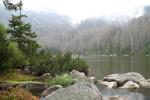History of Aluminium Runoff from Catchment into Plesne Lake
HBI ASCR in co-operation with University of Maine (US) reconstructed the history of terrestrial export of aluminium (Al) to Plešné Lake (Czech Republic) since the lake origin 12,600 BC, and predicted Al export for 2010–2050 on the basis of mass budget studies, palaeolimnological data, and MAGIC modelling. We focused on three major Al forms; ionic Al (Ali), organically-bound Al (Alo), and particulate Al hydroxide (Alp) and their effect on P cycle in the lake. In early post-glacial time, Plešné Lake received high terrestrial export of Al, but with a minor proportion of Alp (4–25 µM), and concentrations of Ali and Alo were negligible, as well as Al effect on P release from sediments. Since the forest and soil development (9900–9000 BC), erosion has declined and soil organic acids increased export of Alo from soils. Photochemical liberation of Ali from Alo and resulted in P immobilization in lake sediments and prevented P release to the water column. The terrestrial Alo leaching (7.5 µM) persisted throughout the Holocene until the industrial period. Then, Ali concentrations continuously increased (up to 28 µM in the mid-1980s) due to atmospheric acidification, and the Al effect on the in-lake P cycling further progressed. Plešné Lake rapidly recoveries from acidification due to a decline in acidic deposition and Alo (5.5 µM) is predicted to dominate Al concentrations around 2050.















